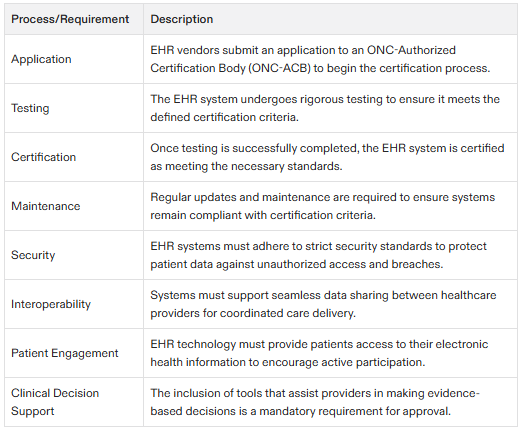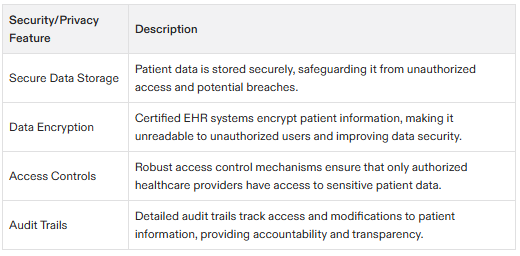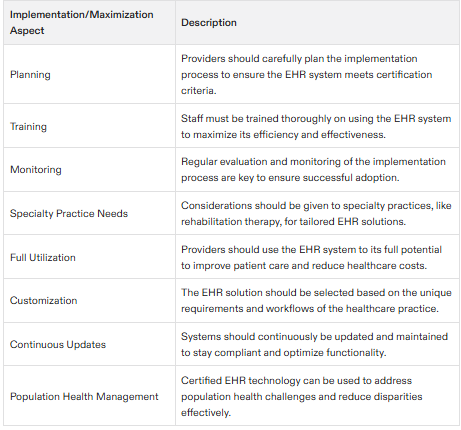Certified EHR
Understanding Certified EHR Technology: Key Features and Benefits for Providers
What is Certified EHR Technology?
Certified EHR technology is a standardized, regulated method for improving patient outcomes through technology.
It is designed to improve the quality of care, reduce healthcare costs, and improve population health. Certified health record technology (CEHRT), as mandated by the 21st Century Cures Act, ensures that electronic health records comply with established standards and certification processes, facilitating effective data capture and sharing.
Certified EHR technology is required for 180 days out of the performance year for Medicare Promoting Interoperability Program.
The use of certified EHR technology is beneficial for healthcare providers, including rehab therapy practices.
EHR Certification Process and Requirements
The EHR certification process is a rigorous and voluntary journey that ensures EHR systems meet specific standards and criteria set by authoritative bodies. The Office of the National Coordinator for Health Information Technology (ONC) and the Centers for Medicare & Medicaid Services (CMS) have established these requirements for certified EHR technology (CEHRT). To achieve certification, EHR vendors must satisfy the criteria of the 2015 Edition and successfully pass a series of tests.
The certification process involves several critical steps:
Application: EHR vendors begin by submitting an application to an ONC-Authorized Certification Body (ONC-ACB) to initiate the certification process.
Testing: The EHR system undergoes rigorous testing to ensure it meets the established certification criteria.
Certification: Upon passing the tests, the EHR system is awarded certification, signifying it meets the necessary standards.
Maintenance: Certified EHR systems must undergo regular maintenance and updates to ensure ongoing compliance with certification criteria.
The certification criteria encompass several key areas:
Security: EHR systems must adhere to stringent security requirements to protect patient data from unauthorized access and breaches.
Interoperability: EHR systems must be capable of exchanging patient data seamlessly with other healthcare providers and systems, promoting coordinated care.
Patient Engagement: EHR systems must empower patients by providing them with access to their electronic health information, enhancing patient engagement and involvement in their care.
Clinical Decision Support: EHR systems must offer clinical decision support tools to assist healthcare providers in making informed, evidence-based decisions.
By meeting these certification criteria, EHR technology ensures that healthcare providers can rely on robust, secure, and interoperable systems that enhance patient care and operational efficiency.
Benefits of Certified EHR Technology
Certified EHR technology supports the use of health information technology.
It promotes the use of electronic health records and improves health information exchange.
Certified EHR technology ensures EHR systems can work with other systems to share information.
It gives assurance that an EHR system or module offers necessary technological capability, functionality, and security to meet meaningful use criteria.
Key Features of Electronic Health Records
Electronic health records (EHRs) store patient data in a structured format for efficient capture and sharing.
Structured data enables easy retrieval and transfer of patient information, improving patient care.
EHRs can connect with other provider types to coordinate care and improve care quality.
Data is stored using a standardized “language,” allowing health information to be used by all providers to deliver evidence-based, quality intervention.
Regulatory Compliance and Incentives
Certified EHR technology is necessary for healthcare providers to meet regulatory requirements and improve patient care.
The Medicare Promoting Interoperability Program requires the use of certified EHR technology.
Providers not using certified EHR for 180 days out of the performance year will lose valuable points and may face the 9% downward payment adjustment to their Medicare reimbursements.
Certified EHR technology qualifies medical practices for federal incentive programs.
EHR incentive programs encourage healthcare providers to adopt and utilize EHR through financial incentives, evolving from Medicare EHR Incentive Programs to Promoting Interoperability Programs to improve access to health information and compliance requirements.
Promoting Interoperability
The Medicare Promoting Interoperability Program aims to promote interoperability and improve health information exchange.
The program focuses on improving patients’ access to health information.
Certified EHR technology is designed to make patients’ electronic health record data privately and securely available to both patients and their authorized providers.
The program reduces the time and cost required of providers to comply with program requirements.
Selecting the Right EHR Technology
Healthcare providers should select EHR technology that meets their unique needs.
AmericanEHR Partners provides the ability for a physician to rate or comment on EHR systems.
There are also message boards that facilitate group discussion and allow users to refine their search for product information by using criteria that are most relevant to them.
The Office of the National Coordinator for Health IT’s (ONC) website provides information on certified EHR technology.
Privacy and Security
Certified EHR technology undergoes focused security evaluation as part of the certification process.
EHR systems must meet criteria for certification to be considered certified.
The U.S. Department of Health and Human Services sets requirements for certified EHR technology to ensure privacy and security.
Certification ensures EHR systems meet security requirements and can maintain data confidentiality.
As part of both HIPAA and Meaningful Use requirements, healthcare providers must conduct or review a security risk analysis at least once during each program year.
Protecting Patient Safety and Security
Certified EHR technology (CEHRT) plays a pivotal role in safeguarding patient safety and security. CEHRT is meticulously designed to ensure that patient data is accurate, up-to-date, and protected from unauthorized access. The certification process includes a comprehensive security evaluation to ensure that EHR systems meet specific security requirements.
Here are some of the ways CEHRT protects patient safety and security:
Secure Data Storage: CEHRT ensures that patient data is stored securely, protecting it from unauthorized access and potential breaches.
Data Encryption: CEHRT mandates that EHR systems encrypt patient data, making it unreadable to unauthorized users and enhancing data security.
Access Controls: CEHRT requires EHR systems to implement robust access controls, ensuring that only authorized healthcare providers can access sensitive patient data.
Audit Trails: CEHRT requires EHR systems to maintain detailed audit trails, tracking access to patient data and providing a record of who accessed what information and when.
By ensuring that EHR systems meet these stringent security requirements, CEHRT helps to protect patient safety and security, fostering trust and confidence in electronic health records. This not only enhances the quality of patient care but also ensures compliance with regulatory standards, such as HIPAA, thereby reducing the risk of data breaches and other security incidents.
Implementing Certified EHR Technology
Implementing certified EHR technology requires careful planning and execution.
Healthcare providers should ensure that their EHR system meets the certification criteria.
Providers should also ensure that their staff is trained on the use of the EHR system.
The implementation process should be monitored and evaluated to ensure successful adoption.
Specialty Practice Considerations
Specialty practices, such as rehab therapy practices, have unique needs when it comes to EHR technology.
Raintree Systems offers the only certified EHR designed specifically for the outpatient rehabilitation therapy practice setting.
The choice of EHR technology will depend on the needs of the practice.
Healthcare providers should select EHR technology that meets their unique needs.
Maximizing the Value of Certified EHR Technology
Certified EHR technology can improve patient care and reduce healthcare costs.
Healthcare providers should use certified EHR technology to its full potential.
Providers should ensure that their staff is trained on the use of the EHR system.
The use of certified EHR technology can also improve population health and reduce healthcare disparities.





